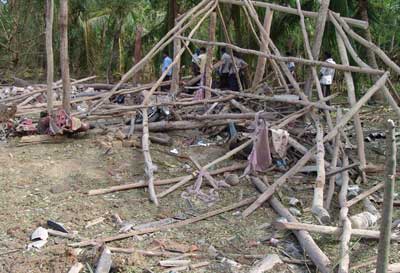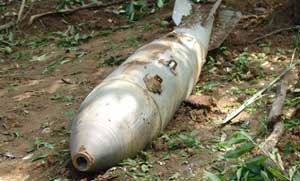
2008 Year of War, ban on LTTE likely
Despite the customary lull during the Christmas season, an intelligence warning last Monday sounded a note of caution. It said the Sea Tigers were planning to attack Dvora fast attack craft (FACs) of the Navy in the North in the next day or two. There had been considerable radio traffic as preparations had got under way for this purpose. Christmas day passed without any major incident. The next day, Wednesday, as it neared noon indications of a build up of guerrilla boats in the seas off the island of Delft caused concern for the Navy's northern command headquarters in Kankesanthurai. The delft island (Neduntivu in Tamil) is the largest among a cluster and lies southwest of the Jaffna peninsula. Historical accounts, in the years of yore, speak of the place being abound with stags, hares and peacocks. However, today there are only wild ponies. There were two Dvora FACs on patrol somewhere west of the Delft island. Three more craft that are similar joined in as a precautionary measure. The small flotilla was patrolling the seas. Soon a larger flotilla of Sea Tiger boats, at least 16, including two, said to be with suicide cadres on board, appeared in the vicinity. The Navy FACs were asked, as a tactical measure, to move a safe distance away. This is until the Navy mustered strength, including air cover, to take on the larger guerrilla presence. They were in the process of doing this.
A suicide boat caught up with the Dvora FAC that was last in the Navy convoy. It had evidently slowed down. When it exploded, the vessel was badly damaged and it sank. The Navy was engaged in salvage operations to re-float it for repairs. The remaining Dvora FACs swung into action. Whilst some of them engaged the Sea Tiger boats, others rescued a sailor. They also recovered the body of Lieutenant Commander Lalith Ekanayake, the commanding officer and another sailor. Eleven others are declared missing in action and are feared dead. The Liberation Tigers of Tamil Eelam (LTTE) claimed that four of its cadres had died in the encounter that lasted nearly four hours. However, the Navy dismissed these claims and declared over 40 guerrillas were killed and their boats destroyed. This is both during encounters with the Navy and after the air support they received. An Air Force Mi-24 helicopter gunship and a Kfir fighter jet strafed guerrilla boats. They gave chase to the withdrawing boats that sped towards a base near the Kokilai area, located on the coast in the northeastern fringe. Independent verification of casualty counts is not possible. The Navy also dismissed LTTE claims that another fast attack craft was badly damaged whilst a third was also hit. Some of the other details related to this incident, though very much in the public interest, cannot be revealed for more than one reason.
With the incident over, intelligence circles are examining whether the attack on the Navy Dvora FACs was a diversion. This was to engage the Navy whilst a smuggling operation, possibly across the Gulf of Mannar from neighbouring Tamil Nadu, was under way. Fuelling suspicion is the acute shortage of fuel in guerrilla dominated Wanni after supplies to the area were considerably restricted. Were quantities of fuel smuggled in during the confrontation? Or, was it other military hardware or medical supplies purchased in Tamil Nadu and stored in their safe houses there? In the past weeks, intelligence authorities have learnt, that the guerrillas were asking senior State officials with entitlement to use official vehicles in the Wanni to cross the checkpoint at Omanthai and travel to Government held Vavuniya. They have been told to fill their fuel tanks and return. Once that is done, the guerrillas were taking the vehicles to their own bases in the Wanni and emptying the fuel. A fuel shortage is not the only logistic requirement to hit the LTTE. They claim that the shortage of drinking water, among other matters, prompted them to pull out of some areas ahead of the Madhu church. Heavy rains have turned wells into muddy water. Indications that the guerrillas were also stepping up attacks emerged this week. In one, the General Officer Commanding (GOC) the Army's 57 Division, Major General Jagath Dias escaped unhurt when a claymore mine was exploded at Kidachuri near Vavuniya on Thursday night. The headquarters of this Division is located in Vavuniya. He was travelling in a vehicle when the incident occurred and left two soldiers injured. In another incident, the guerrillas targeted three members of the Eelam People's Democratic Party (EPDP) who were distributing their newspaper. A claymore mine fixed to a bicycle exploded at Kurumankaadu near Vavuniya killing the trio and a young girl. The incident had taken place a little distance away from a military checkpoint. There were also a string of skirmishes at the defended localities in Muhamalai and near Mannar. In the Eastern theatre of conflict, which is now largely under Government control, there have been minor skirmishes too. In one, a claymore mine explosion hit the engine of a train heading from Trincomalee to Colombo at Kantalai last Sunday night. There was no damage though the guerrilla activity in that area has caused some concern to security authorities. On Thursday morning, guerrillas attacked a Police Special Task Force (STF) foot patrol. An STF commando was killed and a police officer injured. In a sudden and unexpected move, the Security Forces Commander, East was this week transferred to Army Headquarters in Colombo. Taking his place is Major General Jammika Liyanage. As Brigadier, he was the Director of Military Intelligence (DMI). Upon his promotion as Major General, he was earlier tipped to become Director General of Military Intelligence (DGMI). The current year which ends at midnight tomorrow has seen not only a marked escalation of the undeclared Eelam War IV but also witnessed a new facet - the demonstration of air capability by the guerrillas. However primitive such a capability is, this new factor caused concerns for the Government and prompted neighbouring India to study threat perceptions to perceived targets in the southern state of Tamil Nadu. Matters relating to this formed an integral part of discussion when a high-powered defence delegation from India was in Colombo a week ago. On April 29 guerrilla aircraft dropped bombs at the Kolonnawa oil installations and the gas storage facility at Muthurajawela. Guerrilla aircraft also supported a ground attack by their cadres on the Air Force base at Anuradhapura on October 22. Among the other major attacks was the attempt on the life of EPDP leader and cabinet minister, Douglas Devananda by a suicide bomber on October 19. On the same day an improvised explosive device (IED) exploded inside a shop at Nugegoda killing 20 and injuring 43. Tiger guerrilla attacks on civilians included one where on December 5 the guerrillas exploded a claymore mine in Kebettigollawa. It killed 19 and wounded 35 who were travelling in a bus. Major disasters were averted when large hauls of explosives were detected on two different occasions in June. One found in a lorry contained 562 kilogrammes of C-4 whilst another held over 1,000 kilogrammes of the same variety. Triggering explosions using them would have caused immense damage to life and property. The Army also scored a string of successes by re-capturing land previously dominated by Tiger guerrillas. It included the Sampur area in Trincomalee district, Vakarai and Toppigala in the Batticaloa district. Later, in September they re-captured areas in and around Silavathurai, south of Mannar. Also notching up successes were the Navy and the Air Force. One main encounter in which the Navy succeeded was the attack in September on three LTTE cargo vessels. It took place in international waters 1,400 nautical miles away from Sri Lanka. It was in the deep seas off Sumatra. Three LTTE cargo vessels were destroyed. The Air Force has been conducting repeated air raids on guerrilla positions both in the North and East. In one such raid on November 2, the leader of the LTTE Political Wing, S.P. Thamilselvan was killed. Even this week, Air Force fighter jets bombed several guerrilla positions. In one of the raids, a 250 kilogramme bomb that was dropped did not explode. See picture on this page. In the Wanni, LTTE leader Velupillai Prabhakaran, replaced P. Nadesan as the "Tamil Eelam Police Chief" with his deputy, K. Elango. The LTTE said the "appointment" was from November 19. Mr. Nadesan will now function full time as head of the LTTE Peace Secretariat, a post where more than the peace process, all liaison activity with civilians in the Wanni are carried out. With the New Year only a day away, Government leaders have made public pronouncements that the military campaign against Tiger guerrillas would be stepped up. President Mahinda Rajapaksa told a public rally in Matara last Wednesday that he would wipe out terrorism before a settlement is found to the ethnic problem. On Friday, Prime Minister Ratnasiri Wickremanayake told a Presidential Awards ceremony that Sri Lanka could expect to dedicate 2008 "as the year in which terrorists would be comprehensively defeated and totally eliminated." In this backdrop, the recruitment campaign for fresh troops has met with considerable success. Since June to December, this year, according to highly placed Army sources, more than 30,000 have been recruited to their ranks. This includes 4,360 soldiers who availed themselves of the last general amnesty. They have returned to their respective units. It also includes nearly 600 who had completed their mandatory terms and retired from service. A higher intensity war in the coming year is bound to assume a new character. This is in the light of moves by those at the highest levels of the Government to ban the LTTE and abrogate the Ceasefire Agreement of February 2002. According to present indications the move will materialise anytime in the coming weeks. When this materialises, there are also moves to introduce a string of austerity measures which Sri Lankans will be called upon to observe. Other restrictions now under consideration cannot be divulged for obvious reasons. Such a move will not only become a war that is formally declared but will see the end of the role of the Sri Lanka Monitoring Mission (SLMM). However, most of their previous role is almost defunct; its members are still present in Sri Lanka. They have been compiling their own reports on ceasefire violations and other related matters. More importantly, it will also see an end to the role of Norway's peace facilitation efforts under the CFA. What Major General Carl. Von Clausewitz said in his treatise on War over a century ago still rings true. His words: Savage peoples are ruled by passion, civilized peoples by the mind. The difference, however, lies not in the respective nature of savagery and civilization, but in their attendant circumstances, institutions, and so forth. The difference, therefore, does not operate in every case, but it does in most of them. Even the most civilized of peoples, in short, can be fired with passionate hatred of each other." Year 2008 will no doubt be a very challenging one. It will also be critical one for Sri Lanka and her citizens since it has been characterized as the Year of the War by our political, military and other bureaucratic leaders. |
|| Front
Page | News | Editorial | Columns | Sports | Plus | Financial
Times | International | Mirror | TV
Times | Funday
Times || |
| |
Reproduction of articles permitted when used without any alterations to contents and the source. |
© Copyright
2007 | Wijeya
Newspapers Ltd.Colombo. Sri Lanka. All Rights Reserved. |



 The guerrillas had laid land mines and booby trapped the area with IED (Improvised Explosive Devices) before withdrawing.
In other areas in the vicinity, the same sources said they have re-captured vast tracts of territory after bitter gun battles. This included the 54 or “Hub” base of the LTTE. The map on this page shows some of the areas that have now come under Army control. Some of the areas were re-captured on Friday.
The guerrillas had laid land mines and booby trapped the area with IED (Improvised Explosive Devices) before withdrawing.
In other areas in the vicinity, the same sources said they have re-captured vast tracts of territory after bitter gun battles. This included the 54 or “Hub” base of the LTTE. The map on this page shows some of the areas that have now come under Army control. Some of the areas were re-captured on Friday. The LTTE used for the first time two of its Czech built Zlin Z-143 aircraft to drop bombs at the Air Force base at Katunayake - a move that prompted the late night closure of the Bandaranaike International Airport (BIA) for three months. There was an aerial attack on the military complex in Palaly on April 7.
The LTTE used for the first time two of its Czech built Zlin Z-143 aircraft to drop bombs at the Air Force base at Katunayake - a move that prompted the late night closure of the Bandaranaike International Airport (BIA) for three months. There was an aerial attack on the military complex in Palaly on April 7.